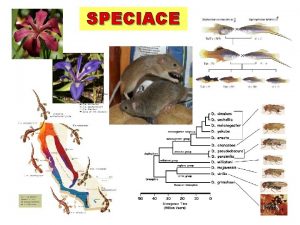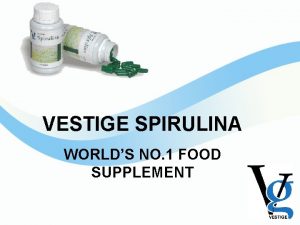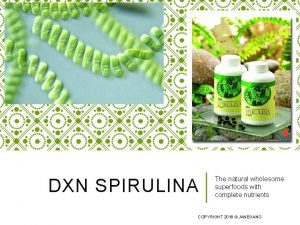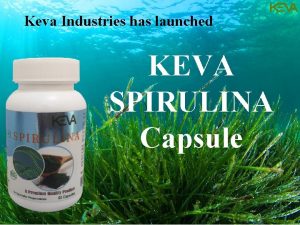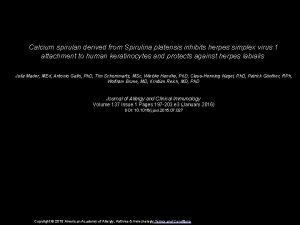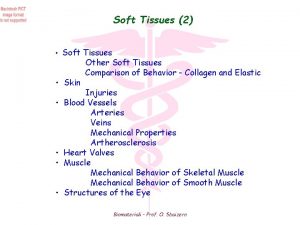INCORPORATION OF SPIRULINA PLATENSIS ON TRADITIONAL GREEK SOFT














- Slides: 14

INCORPORATION OF SPIRULINA PLATENSIS ON TRADITIONAL GREEK SOFT CHEESE WITH RESPECT TO ITS NUTRITIONAL AND SENSORY PERSPECTIVES LOULOUDA BOSNEA 1 *, ANTONIA TERPOU 1, 2 , ELENI PAPPA 1 , EFTHYMIA KONDYLI 1 , MARIOS MATARAGKAS 1 , GEORGIOS MARKOU 3 , GEORGIOS KATSAROS 3 1 2 3 HELLENIC AGRICULTURAL ORGANIZATION DEMETER, DAIRY RESEARCH INSTITUTE, KATSIKAS, 45221, IOANNINA, GREECE. SCHOOL OF AGRICULTURAL DEVELOPMENT, NUTRITION & SUSTAINABILITY, DEPARTMENT OF AGRICULTURAL DEVELOPMENT, AGRI-FOOD, AND NATURAL RESOURCES MANAGEMENT, NATIONAL AND KAPODISTRIAN UNIVERSITY OF ATHENS, PSACHNA, 34400, EVIA, GREECE. HELLENIC AGRICULTURAL ORGANIZATION DEMETER, INSTITUTE OF TECHNOLOGY OF AGRICULTURAL PRODUCTS, LEOF. SOFOKLI VENIZELOU 1, 14123, ATHENS, GREECE.

INTRODUCTION • Milk and dairy products have an important role in human diet due to their nutritional benefits from proteins, mineral and vitamin. Especially in Greece, dairy products are consumed massively and are important part of the daily Greek diet. • Recently, food scientists have tried the fortification of dairy products using natural products to ameliorate the overall dietary intake of foods with minimal effects

MICROALGAE Microalgae are known to be rich in proteins, amino acids, vitamins, and various minerals, as well as polysaccharides, sterols, and fatty acids. They have great potential to be used as fortification products in dairy as they contain various macro- components (polysaccharides and sulphated polysaccharides as stabilizer) and micro-components (polyunsaturated fatty acids as bioactive compounds and pigments as a coloring agent) posing important functional characteristics

SPIRULINA PLATENSIS • the most popular microalgae species known for its high protein content and bioactive compounds • has been studied as such potential natural resource for dairy products fortification. • incorporation of dried Spirulina in dairy products poses major sensorial challenges due to its characteristic odor and its insolubility in food formulation thus limiting consumer acceptance.

SPIRULINA COMPOSITION 3 -7 % moisture 55 -68% protein Major protein are γ-phycocyanine (~20%) and allophycocyanine 6 -8% lipids 12 -20% carbohydrates 7 -10% ash (iron and calicum) 8 -10% dietary fibres 0. 5% carotenoids (~0, 2% β-carotene) 1 -1. 5% chlorophyl Large range of vitamins (Ε, C, B 12, provitamine Α) 45 -50% saturated fatty acids 50 -55% unsaturated fatty acids 30% is γ-linolenic acid

SPIRULINA PROPERTIES antivirus Anticarginogenic antinflamarory Antioxidative Reduces blood sugar

OBJECTIVES The main objectives of the current study were: to produce a novel functional soft cheese fortified with powdered Spirulina, to determine the concentration of S. platensis that can be added to the product and to evaluate its effects on the physicochemical, textural and sensorial characteristics of the produced cheese.

MATERIALS AND METHODS Production of spirulina enriched fresh soft cheese 24 kg of ewe’s milk was collected after milking and cloth filtered to remove contaminants and external material heated up to 85 °C cooled down to 35 °C and yogurt culture was added divided into equal portions (6 Kg each) in stainless steel buckets with a lid. Addition of 1 m. LKg-1 of milk Ca. Cl 2 (40% w/v) and liquid commercial rennin (1 m. LKg-1) samples were placed in a chamber at 20 o. C for 24 h. After 24 h the curd was removed from each container and placed into perforated fabric called ‘tsandila’ for cheese whey removal. The cheese curd of each sample is left to drain into the fabric bags in a chamber at 12 o. C for 48 h. Cheese curd was moved from the fabric bags, weighed and placed in special storage containers and salt (type 2, 1 gkg-1 of cheese) and spirulina in powder form (0. 25, 0. 5, and 1 gkg-1) were added. Figure 1. : Manufacture stages of galotyri fresh cheese. (a) Samples removed from their initial containers and placed into perforated fabric called ‘tsandila’ targeting cheese whey removal; (b) The cheese curd of each sample is left to drain into fabric bags in a chamber at 12 o. C for 48 h; (c) Cheese curd retrieved after drainage. (d) Addition of powder spirulina in fresh cheese;

RESULTS • Table 1. Chemical composition of fresh cheese so named ‘galotyri’ determined 2 days after the addition of salt and powered spirulina.

• Table 2. Microbiological profile of galotyri during cold storage at 4 o. C for 60 days. Mesophilic Cheese Sample Days of storage Molds and lactobacilli Mesophilic lactococci Staphylococci Total coliforms Total enterobacteria yeasts 7. 71± 0. 09 a 9. 61± 0. 11 a 1. 45± 1. 45 a 0. 95± 0. 95 a 0. 89± 0. 89 a 0. 0± 0. 0 8. 88± 0. 08 c 9. 32± 0. 03 a 0. 00± 0. 0 a 0. 8± 0. 8 a 1. . 04± 1. 04 a 0. 0± 0. 0 8. 21± 0. 14 b 9. 41± 0. 16 a 0. 93± 0. 93 a 1. 63± 0. 63 a 1. 7± 0. 7 a 0. 0± 0. 0 0. 25% spirulina 7. 88± 0. 02 ab 9. 63± 0. 10 a 0. 00± 0. 0 a 1. 7± 0. 7 a 1. 73± 0. 73 0. 0± 0. 0 Control 9. 24± 0. 06 ab 5. 31± 0. 41 a 0. 00± 0. 00 a 0. 00± 0. 0 a 3. 11± 0. 11 c 9. 15± 0. 05 ab 5. 27± 0. 07 a 0. 00± 0. 0 a 0. 5± 0. 5 ab 0. 5± 0. 5 a 2. 6± 0. 4 bc 9. 74± 0. 07 b 5. 45± 0. 10 a 0. 00± 0. 0 a 1. 43± 0. 43 a 0. 5± 0. 5 a 1. 68± 0. 18 ab 8. 89± 0. 35 a 5. 67± 0. 05 a 0. 5± 0. 5 a 1. 24± 0. 24 ab 1. 5± 0. 5 a 1. 24± 0. 24 a 4. 9± 0. 1 a 7. 73± 0. 03 a 0. 00± 0. 0 a 3. 11± 0. 11 a 5. 58± 0. 08 b 7. 75± 0. 15 ab 0. 00± 0. 0 a 1. 99± 0. 99 a 5. 1± 0. 1 a 8. 09± 0. 11 b 0. 00± 0. 0 a 2. 39± 0. 59 a 0. 25% spirulina 5. 73± 0. 03 b 7. 89± 0. 04 ab 0. 5± 0. 5 a 0. 00± 0. 00 a 0. 5± 0. 5 a 2. 43± 0. 43 a Control 4. 74± 0. 14 ab 8. 72± 0. 22 a 0. 85± 0. 85 a 0. 00± 0. 0 a 5. 48± 0. 22 a 5. 32± 0. 12 b 8. 96± 0. 06 a 0. 00± 0. 0 a 1. 95± 0. 05 b 1. 6± 0. 1 b 4. 26± 0. 06 b 4. 55± 0. 25 a 8. 82± 0. 22 a 0. 00± 0. 0 a 4. 18± 0. 08 b 0. 25% spirulina 4. 68± 0. 09 a 8. 84± 0. 07 a 0. 5± 0. 5 a 0. 00± 0. 00 a 0. 00± 0. 0 a 3. 98± 0. 18 b Control 4. 06± 0. 06 a 8. 23± 0. 03 a 0. 00± 0. 00 a 5. 3± 0. 05 b 5. 4± 0. 2 c 9. 05± 0. 15 b 0. 00± 0. 00 a 5. 56± 0. 1 b 4. 36± 0. 06 ab 9. 2± 0. 1 b 0. 00± 0. 00 a 5. 3± 0. 01 b 0. 25% spirulina 4. 69± 0. 09 b 8. 6± 0. a 0. 00± 0. 00 a 4. 98± 0. 09 a Control 4. 56± 0. 04 a 8. 45± 0. 05 a 0. 65± 0. 65 a 0. 00± 0. 00 a 6. 48± 0. 02 b 6. 25± 0. 05 c 7. 92± 0. 12 b 0. 00± 0. 00 a 5. 34± 0. 14 a Control 1% spirulina 0. 5% spirulina 7 14 0. 25% spirulina Control 1% spirulina 0. 5% spirulina 1% spirulina 21 30 45 60

DISCUSSION • The chemical composition of galotyri was determined during storage at 4 o. C after two days of production (Table 1). Products of microalgae origin have been widely used as a high-protein supplements especially in human nutrition as well as for nutraceutical purposes. In the present study a slight rase in protein content was observed as the content of incorporated spirulina was incorporated in higher amounts. This result was mostly expected as Spirulina platensis is one of the most nutritious microalgae known containing a wide capacity of essential amino acids and protein content of up to 70% of its dry biomass • Microorganisms in dairy products impose a significant impact on physicochemical and organoleptic characteristics of the final product. Likewise, microbial stability is of crucial role for maintenance of cheese products original character. In the present study, the different concentrations (0. 25, 0. 5, 1%) of incorporated spirulina did not affect the final microbiological profile of produced cheeses (Table 2). The usual storage days of microbiological accepted fresh cheeses such as galotyri is up to 30 days after production. Likewise, in the present study, we can observe the increase in population of possible spoilage microorganism such as yeast and moulds after 60 days of storage in all cheese samples.

CONSUMERS ACCEPTANCE TEST • Spirulina as most microalgae is known to pose an undesirable odor. As matter of fact scientific researcher have investigated methods targeting to reduce the algae-related odor of Spirulina using activated charcoal absorption, heating, lysozyme enzymatic hydrolysis, β-cyclodextrin inclusion, fermentation, and solvent extraction. • Likewise, in the present study algae-like odor was detected in cheese samples but in the intense of powder spirulina. Specifically, the cheeses with incorporated 0. 25 and 0. 5 % spirulina were mostly preferred by the panelists as they posed a less intense odor and taste of spirulina. • In general, all cheese samples received high scores of preferences and were characterized as acceptable for consumption by the expert’s evaluation panel.

CONCLUSION Microalgae biomass is considered a sustainable source of proteins that can meet the growing global demand for these biomolecules. Spirulina is one of the most nutritious microalgae known and can reach protein content of up to 70% of the dry biomass. Spirulina poses great potential to be used as functional fortification ingredient in dairy. Likewise, in the present study the protein fortification, microbiological stability and consumers acceptance were verified in the production of a novel fresh cheese containing powder spirulina providing a nutritional product will in parallel the original recipe and character of traditional galotyri cheese were preserved.

Funding: This research (MIS number: 5040303, project title: Innovative cheese products with microalgae) was funded by the action ‘Support of research, development and innovation projects- RIS 3 Agri-foods’ and was co-financed by the European Union (European Regional Development Fund) and Greece, under the “Operational Program Western Greece 2014– 2020” of the National Strategic Reference Framework.
 Speciace
Speciace Elken product
Elken product Vestige spirulina capsules benefits
Vestige spirulina capsules benefits Spirulina pregnancy
Spirulina pregnancy Keva spirulina
Keva spirulina Fusion method of ointment preparation
Fusion method of ointment preparation Procedure for incorporation of company
Procedure for incorporation of company Consequences of incorporation
Consequences of incorporation Asas place of incorporation
Asas place of incorporation Definition of selective incorporation
Definition of selective incorporation Howard zhang davis polk
Howard zhang davis polk Brenda andrews oklahoma
Brenda andrews oklahoma Real seat theory vs incorporation theory
Real seat theory vs incorporation theory Selective incorporation definition
Selective incorporation definition 450000/12
450000/12
